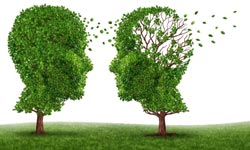Toward an early diagnostic tool for Alzheimer’s disease

Despite all the research done on Alzheimer’s, there is still no early diagnostic tool for the disease. By looking at the brain wave components of individuals with the disease, Professor Tiago H. Falk of INRS’s Centre Énergie Matériaux Télécommunications has identified a promising avenue of research that may not only help diagnose the disease, but also assess its severity. This non-invasive, objective method is the subject of an article in the journal PLOS ONE.<br>
But as scientists have already discovered, activity in certain areas of the cerebral cortex is affected even in the early stages of the disease. Professor Falk, who specialises in biological signal acquisition, examined this phenomenon and compared the electroencephalograms (EEGs) of healthy individuals (27), individuals with mild Alzheimer’s (27), and individuals with moderate cases of the disease (22). He found statistically significant differences across the three groups.
In collaboration with neurologists and Francisco J. Fraga, an INRS visiting professor specializing in biological signals, Professor Falk used an algorithm that dissects brain waves of varying frequencies. “What makes this algorithm innovative is that it characterizes the changes in temporal dynamics of the patients’ brain waves,” explains Professor Falk.
“The findings show that healthy individuals have different patterns than those with mild Alzheimer’s disease. We also found a difference between patients with mild levels of the disease and those with moderate Alzheimer’s.”
To validate the model in order to eventually develop an early diagnostic tool for Alzheimer’s disease, Professor Falk’s team is sharing their algorithm on the NeuroAccelerator.org online data analysis portal. It is the first open source algorithm posted on the portal and may be used by researchers around the world to produce additional research findings.
Alzheimer’s disease accounts for 60% to 80% of all dementia cases in North America and is skyrocketing. This step toward the development of an early diagnostic tool that is non-invasive, objective, and relatively inexpensive is therefore welcome news for the research community.
About this publication
The article, entitled “Characterizing Alzheimer’s Disease Severity via Resting-Awake EEG Amplitude Modulation Analysis,” was published in the journal PLOS ONE on August 27, 2013. The work of Tiago H. Falk, a professor and researcher at INRS’s Centre Énergie Matériaux Télécommunications, and his coauthors was made possible by funding from the Natural Sciences and Engineering Research Council of Canada and the Foundation for Research Support of the State of São Paulo (Fundação de Amparo à Pesquisa do Estado de São Paulo).
Media Contact
More Information:
http://www.inrs.caAll latest news from the category: Health and Medicine
This subject area encompasses research and studies in the field of human medicine.
Among the wide-ranging list of topics covered here are anesthesiology, anatomy, surgery, human genetics, hygiene and environmental medicine, internal medicine, neurology, pharmacology, physiology, urology and dental medicine.
Newest articles

High-energy-density aqueous battery based on halogen multi-electron transfer
Traditional non-aqueous lithium-ion batteries have a high energy density, but their safety is compromised due to the flammable organic electrolytes they utilize. Aqueous batteries use water as the solvent for…

First-ever combined heart pump and pig kidney transplant
…gives new hope to patient with terminal illness. Surgeons at NYU Langone Health performed the first-ever combined mechanical heart pump and gene-edited pig kidney transplant surgery in a 54-year-old woman…

Biophysics: Testing how well biomarkers work
LMU researchers have developed a method to determine how reliably target proteins can be labeled using super-resolution fluorescence microscopy. Modern microscopy techniques make it possible to examine the inner workings…





















